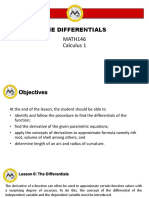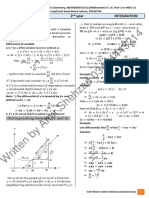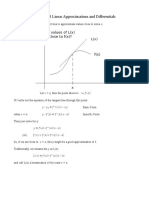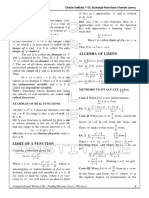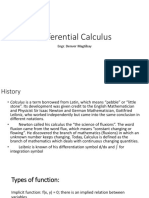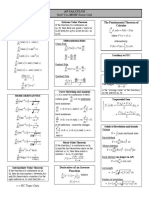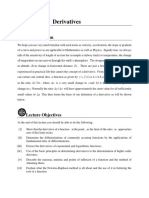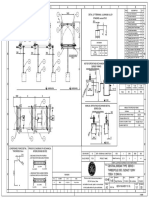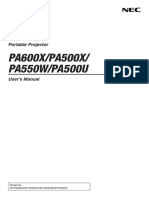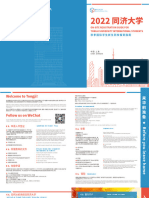Lesson 12
Differentials and
Parametric Equations
OBJECTIVES:
At the end of the lesson, the student should be able to:
DEFINITION OF
DIFFERENTIALS
• Let x represents a function that is differentiable on an
open interval containing x. The differential of x
(denoted by dx) is any nonzero real number.
• The differential of y (denoted by dy) is
dy = f(x )dx.
DIFFERENTIAL
FORMULAS
EXAMPLE 1: Find dy for y = x3 +
5 x −1.
dy d x 5 x 1
3
Note : In practice, we simply get the derivative
3 x dx 5dx
2 of the right member of the equation and
multiply it by dx.
dy 3x 2 5 dx
2x
dy d
3x 1
3 x 1 2 2 x 3
3 x 1 2
6x 2 6x 2dx
dy
2
dy
3 x 1 3 x 1 2
EXAMPLE 3: Use differentials to approximate the change in the area of a
square if the length of its side increases from 6 cm to 6.23 cm.
Let x = length of the side of the square.
The area may be expressed as a function of x,
where A= x2.
The differential dA is dA f ' x dx dA 2 x dx
Because x is increasing from 6 to 6.23, you find that
Δ x = dx = .23 cm; hence, dA 2 6 cm 0.23cm
dA 2.76 cm 2
The area of the square will increase by approximat ely 2.76 cm 2
as its side length increases from 6 to 6.23. Note that the exact
increase in area y is 2.8129 cm 2 .
EXAMPLE 4: Use the local linear approximation to estimate the
value26of
3
.55 to the nearest thousandth.
Because the function you are applying is f x 3 x , choose a convenient
value of x that is a perfect cube and is relatively close to 26.55, namely
x 27. The differenti al dy is
1
dy f' x dx f x x3
1 23 1
dy x dx 2 dx
3 3x 3
Because x is decreasing from 27 to 26.55, then x dx 0.45
1 1 45 1
Hence , dy 2 0.45 0.0167
3 27 3 27 100 60
1
which implies that 3
26.55 will be approxima tely
60
1
less that 3
27 3; therefore 3
26.55 3
60
3
26.55 3 - 0.0167 2.983
EXAMPLE 5: If y = x3 + 2x2 – 3, find the approximate value of y
when x = 2.01.
The exact value is y y but since we are simply asked
to find the approximate value, then we shall solve for
y dy. Note that if we write 2.01 2 0.01, then we are
considering 2.01 as the result of applying an increment
of x dx 0.01 to an original value of x 2.
Since y x 3 2x 2 3
then dy 3x 2 4x dx
when x 2, then y 8 8 3 13
and when x 2 and dx 0.01, then
dy 12 8 0.01 0.20
therefore , the required approximat ion is
y dy 13 0.20 13.20
EXAMPLE 6: Use an appropriate local linear approximation
to estimate the value of cos 310.
Let y cos x
then dy sin x dx
when x 30 0 , then y cos 30 0 0.866
and when x 30 and dx 1
0 0
0
0.01745, then
180
dy sin 30 0 10 0
180
dy 0.5 0.01745 0.008725
therefore , the required approximat ion is
y dy 0.866 0.008725 0.8573
Derivative of Parametric
Equations
EXAMPLES :
Find the derivatives of the following parametric equations :
1. x 8cost 5cos4t, y 8sin t - 5sin4t
dx
8 sin t 20 sin 4 t and
dt
dy
8 cos t 20 cos 4 t
dt
dy
dy dt 8 cos t 20 cos 4 t
dx dx 8 sin t 20 sin 4 t
dt
4 2 cos t 5 cos 4 t
4 2 sin t 5 sin 4 t
2 cos t 5 cos 4 t
2 sin t 5 sin 4 t
d2 y
2. If x t 1, y t t,
3 2
find 2
dx
dy
dy dt 2t 1
dx dx 3t 2
dt
d2 y d 2t 1 dt
2
dx dt 3t dx
2
d2 y 3t2 2 2t 1 6t 1
2
4
2
dx 9t 3t
d2 y 2 t 1
2
dx 9t 5
d2 y
3. If x 2 sin , y 1 4 cos , find 2
dx
dy
dy d 4 sin
2 tan
dx dx 2 cos
d
d2 y d d
2 tan
dx d
2
dx
d2 y 1
2 sec 2
dx 2 2 cos
d2 y
2
sec 2
sec
dx
d2 y
2 sec 3
dx
Example:
I. Use differentials to approximate the value of the following expression.
II. Find the differential dy of the given function.
Examples:

